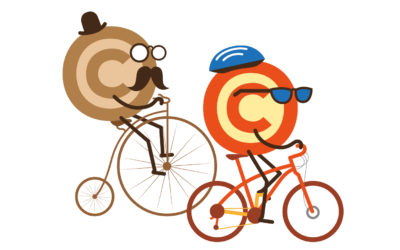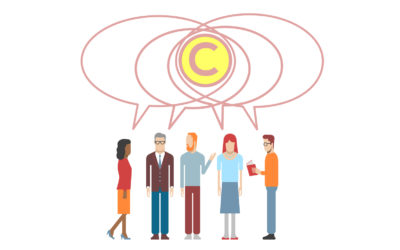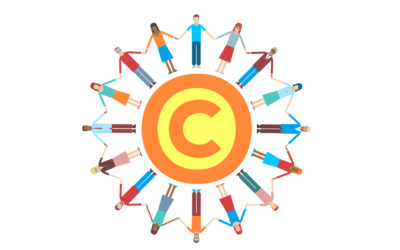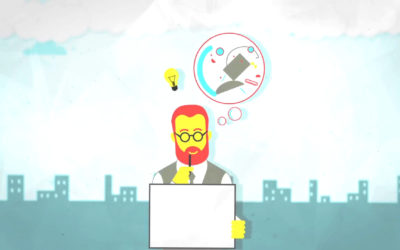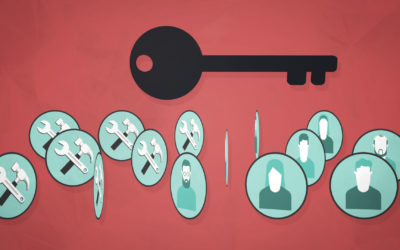Illustration: Davide Bonazzi
How effective is copyright regulation?
1. Introduction
2. Perspectives on Effective Copyright Regulation
3. Perspectives on Ineffective Copyright Regulation
See also:
– Case Study: Netflix
– Task
1. Introduction
Prompt One established that the ultimate purpose of copyright is the creation and spread of knowledge. Prompt Two discussed the arguments supporting and the arguments criticising copyright regulation. This prompt will consider the different perspectives on the effectiveness of copyright regulation in the digital age taken from the stakeholder responses.
Firstly, we will consider the stakeholder responses of effective perspectives on copyright and the benefits that new technologies have provided for creators, copyright owners and the public. Then we will consider the stakeholder responses which illustrate that copyright has not been effective in responding to technological challenges, such as in relation to territoriality and online copyright infringement.
2. Perspectives on effective copyright regulation
As explained in the two previous prompts, copyright has a close relationship with technology. In order to serve its purpose of promoting the creation and spread of knowledge, copyright must respond to the challenge of new technologies in a fair way by balancing the need to protect copyright works whilst allowing the public to use them in certain circumstances.
Some stakeholders believe that copyright law has effectively responded to the challenges of digital technologies.
“Current copyright laws are basically effective in dealing with digital and network technologies.” (Collecting Society)
“They largely work today, and do not require much further amendment.” (Lawyer)
New ways to create and spread work
New technologies have provided many benefits for creators, copyright owners and the public as a whole. For example, some stakeholders agree that new technology is beneficial in creating new ways to innovate. Technology has also made it cheap and easy to create and so encourages more people to create more material.
“The Internet has been a boon to creativity. Today, more music, more video, more text and more software is being created by more people in more places than ever before. Every kind of creative endeavour, both amateur and professional, is being transformed by the new opportunities and lower costs made possible by digital tools and online distribution. One of the most inspiring things about YouTube is the way people around the world use it to express their passion and creativity – and to turn it into a career.” (Internet Service Provider)
New technologies have also made it much easier and cheaper for creators and copyright owners to spread their work as well as allowing the public to access and make use of their work.
“Digital technology and the Internet give everyone the capability to produce and more importantly disseminate material.” (Librarian)
“Technology has made communicating many works very easy and created opportunities for the widespread and efficient use of digital content.” (UK Regulator)
New ways to protect copyright
These digital technologies also provide new ways for creators and copyright holders to safeguard the copyright in their work.
“Technology is advancing and becoming helpful in confronting piracy. We
have technology that tells us when our music is popping up online and sends automatic takedown requests which saves us a lot of time.” (Independent Record Label)
“Google’s Content ID system allows rights holders to deliver reference files of their own content to YouTube and allows the rights holder to decide what YouTube should do when matching content is found. Content ID scans over 250 years of video every day. The rights holder can choose to make money from the matching content by adding an advertisement, or they can simply decide to track the viewing statistics, or alternatively they may decide to block the content from YouTube. This system affords copyright owner’s not just an anti-piracy solution, but also a new business model for copyright owners and YouTube alike. The majority of partners using Content ID choose to monetise their claims and many have seen significant increases in their revenue as a result.” (Internet Service Provider)
3. Perspectives on ineffective copyright regulation
On the other hand some stakeholders believe that copyright has not been effective in responding to new technologies.
“Basic principles need to be revisited in the light of changing technology, and ideally drafted in such a way to be able to accommodate future changes.” (Academic)
“Copyright regulation is a disaster. There are glaring and obvious problems such as orphan works (more than 90% of the works in copyright have no easily discovered owners), of licensing (needing a license to sample a short piece of music has become standard), and of concentration of power (there is too much prohibited activity which means that big commercial companies have too much power).” (Activist)
Territoriality
One of the challenges that new digital technologies have brought to copyright is the issue of territoriality. Copyright is a territorial right; this means that the national laws of the country apply. This is a problem because digital Internet technologies are, of course, global.
“One of the biggest problems with applying copyright to digital works in the 21st Century is that while works are available internationally, copyright ultimately functions nationally. For example, you can only access the iTunes Music Store for the UK if you have a British credit card, and Spotify is only available in some countries, but not others, due to licensing restrictions.” (Academic)
This causes a tension because the public expect to be able to access material from all over the world. It can be frustrating for a user to be restricted access as a result of copyright licensing because of their location and where they live. For example, if you pay a licence fee for a service that provides you with creative work, which can be accessed from a device in your country, the use of this service on your device in another country may be restricted.
“The law that applies to individuals, organisations and society is national. On the other hand, digital and networking technologies are global in scope. Not only that, the expectations of people across the world require that information be available to them wherever they are. These two sets of facts are incompatible in the present state of the law.” (Archive Expert)
“It is often found that online licensing restrictions make it impossible to buy music legally. Sometimes, for example, you can’t buy an MP3 across an EU border. It should be made easier to legally access the music you love, especially across borders.” (European Regulator)
Online infringement
Another concern that technology has raised for copyright is online infringement. This is when users copy or share copyright protected material without the permission from the copyright owner.
“Online piracy remains a challenge.” (Internet Service Provider)
“Regulators have been challenged by the high volume of copyright infringement online.” (Collecting society)
Digital technologies have made it very easy to access copyright protected work without permission or payment to the copyright owner. As discussed in Prompt One, copyright grants the owners control over the use of their work. However, due to new technologies it can be difficult to stop people infringing their work by copying and sharing it online.
“I have never been more widely published or received so little in payment.” (Photographer)
“Digitisation has been with us for some time now, but changes to a law that largely reflects authoring, and using copyright works in an analogue world are forthcoming very slowly.” (Academic)
In order to serve its purpose of promoting the creation and spread of knowledge, copyright must respond to the challenge of new technologies by balancing the different stakeholder interests in a fair way. Copyright must allow the development of innovation and new technologies for the benefit of society as a whole whilst still protecting a copyright owner’s work.
Summary
The development of new technologies has many benefits for creators, copyright owners and society as a whole. Innovation has developed new opportunities for the creation and spread of knowledge as well as providing new ways to protect copyright works.
However, technological developments raise tensions in copyright regulation. There is a problem with the local nature of copyright being applied to global technologies. In addition, online infringement has caused problems for copyright owners not being able to stop people from copying and sharing their work without their permission.
Overall, in order to serve its purpose copyright must strike a balance between protecting the copyright owner’s work and allowing the public to access it. Copyright must also enable the development of new innovations and technologies for the benefit of society whilst still allowing copyright owners to benefit from their works.
Below is a table displaying the main perspectives on effective and ineffective copyright regulation as discussed above.

| Effective Copyright | Ineffective Copyright |
|---|---|
| Technological benefits | Technological challenges |
| New ways to create and spread work | Territoriality |
| New ways to protect copyright | Online infringement |
Case Study: Netflix
Netflix is a provider of on-demand Internet streaming media. Users pay a monthly subscription to have access to a huge catalogue of films and TV shows on demand. It is a good example of a business that is based on the exploitation of copyright protected material. It has adapted to the digital age and used new technology to enhance its service.
“Fifteen years after launching our subscription service, we have over fifty million members enjoying Netflix in over 40 countries.” (Netflix)
Netflix Inc. agrees licensing deals with copyright owners. They are then able to provide the public with access to the copyright works and the copyright owners get paid. This is a very convenient and cheap way for the public to access a large amount of copyright material and still enabling copyright owners to benefit from their work. Online businesses that are able to utilise copyright in a way that meets the consumers’ expectations could have a positive influence in the reduction of copyright infringement online.
“Piracy often arises when consumer demand goes unmet by legitimate supply. As services ranging from Netflix to Spotify to iTunes have demonstrated, the best way to combat piracy is with better and more convenient legitimate services. The right combination of price, convenience, and inventory will do far more to reduce piracy than enforcement can.” (Internet Service Provider)
However, issues of territoriality can be found to restrict what Netflix can provide their customers, depending on what country the customer is accessing the service from. Different countries have different catalogues of material. For Netflix to clear the copyrights in each individual country can be time-consuming and expensive.
Source:
Netflix Second Quarter 2014 Earnings Interview 21st July 2014 – http://ir.netflix.com/eventdetail.cfm?eventid=147185
Task: What permission do you need?
Copyright must enable the development of new innovations and technologies for the benefit of society whilst still allowing copyright owners to benefit from their works.
Consider the copyright implications of the following scenarios:
1. You want to watch your favourite film by streaming it online. Consider what kind of copyright permission is required?
2. You want to provide a video streaming website where other people can come and access copyright protected material. Consider what kind of copyright permission is required?
3. Do you think copyright regulation is effective in striking the balance between creators and users?
Related
Prompt One
What is the nature of contemporary copyright regulation compared with previous practices?
Prompt Two
What are the arguments for and against contemporary copyright regulation?
Prompt Four
What are the wider social issues relating to copyright regulation?
Supplementary Information
Strategies for case studies, information for teachers, useful links and definitions.
Contributors and About the Resource
Authors, contributors, questionnaire respondents and about the resource.

